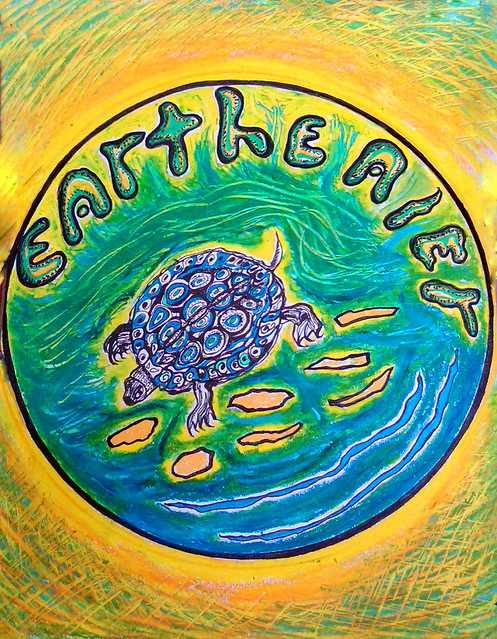
Art Changes Everything – 27/52, BlackBerry 52 — Week 27 Jump-Off for week beginning July 4th, 2011, Minneapolis, Minnesota, June 2011, photo © 2011 by QuoinMonkey. All rights reserved. Medium: Droid snapshot of the wall outside Intermedia Arts, taken Pride weekend, altered in Photoshop Elements, b&w version.
Heat index over 100, sweat soaking through clothes. Last week was one of those weeks when I was searching for inspiration. Lids heavy from the day, the eyes kept roaming, leaped over to the bookshelf, and landed on Ray Bradbury’s Zen In The Art Of Writing. There are books I go back to again and again—for reminders that it’s okay to struggle. For stories about moments of success, paragraphs that sum up in a few words what it means to be an artist or a writer. I don’t separate the two. For me, writing and art are connected. They collectively make up the Arts.
I ran my fingers over the worn cover, then opened Ray’s book to the Preface. That’s as far as I had to go. Maybe a few tidbits in these paragraphs will have meaning for you, too. There are hours when I stop dead in my tracks; I don’t want to write anymore. Somehow, the practice keeps going. Not perfect. Tracks. Cairns inside eroded pockets of sandstone cliffs.
I enter the Preface right after Ray’s story of the day he breathed a second life into his childhood hero, Buck Rogers:
So I collected comics, fell in love with carnivals and World’s Fairs and began to write. And what, you ask, does writing teach us?
First and foremost, it reminds us that we are alive and that it is a gift and a privilege, not a right. We must earn life once it has been awarded us. Life asks for rewards back because it has favored us with animation.
So while art cannot, as we wish it could, save us from wars, privation, envy, greed, old age, or death, it can revitalize us amidst it all.
Secondly, writing is survival. Any art, any good work, of course, is that.
Not to write, for many of us, is to die.
We must take arms each and every day, perhaps knowing that the battle cannot be entirely won, but fight we must, if only a gentle bout. The smallest effort to win means, at the end of each day, a sort of victory. Remember that pianist who said that if he did not practice every day he would know, if he did not practice for two days, the critics would know, after three days, his audiences would know.
A variation of this is true for writers. Not that your style, whatever it is, would melt out of shape in those few days.
But what would happen is that the world would catch up with and try to sicken you. If you did not write every day, the poisons would accumulate and you would begin to die, or act crazy, or both.
You must stay drunk on writing so reality cannot destroy you.
For writing allows just the proper recipes of truth, life, reality as you are able to eat, drink, and digest without hyperventilating and flopping like a dead fish in your bed.
I have learned, on my journeys, that if I let a day go by without writing, I grow uneasy. Two days and I am in tremor. Three and I suspect lunacy. Four and I might as well be a hog, suffering the flux in a wallow. An hour’s writing is tonic. I’m on my feet, running in circles, and yelling for a clean pair of spats.
-Ray Bradbury from the Preface of Zen In The Art Of Writing: Essays On Creativity, © 1990 Ray Bradbury, original from “The Joy of Writing,” Zen & the Art of Writing, Capra Chapbook Thirteen, Capra Press, 1973.
And that is why I went to my studio and ate up the time with myself. So the world would not devour me. Time to sit and listen to music, to stare out the window, to write a few lines of poetry, to sketch at the ragged edges of the page, to find inspiration on a wall outside Intermedia Arts. Time to take up arms and fight, the smallest battle, the smallest effort to win.
Art changes everything.
 Lotus and I will continue to respond to each other’s BlackBerry Jump-Off photos with text, photography, poetry (however we are inspired) for the 52 weeks of 2011. You can read more at BlackBerry 52 Collaboration. If you are inspired to join us, send us a link to your images, poetry, or prose and we’ll add them to our posts.
Lotus and I will continue to respond to each other’s BlackBerry Jump-Off photos with text, photography, poetry (however we are inspired) for the 52 weeks of 2011. You can read more at BlackBerry 52 Collaboration. If you are inspired to join us, send us a link to your images, poetry, or prose and we’ll add them to our posts.
-posted on red Ravine, Thursday, July 7th, 2011
-related to posts: Flying Solo — Dragonfly In Yellow Rain, Dragon Fight — June Mandalas, The Sketchbook Project, Under The Rainbow — Twin Cities Pride
Art Changes Everything – 27/52, BlackBerry 52 — Week 27 Jump-Off for week beginning July 4th, 2011, Minneapolis, Minnesota, June 2011, photo © 2011 by QuoinMonkey. All rights reserved. Medium: Droid snapshot of the wall outside Intermedia Arts, taken Pride weekend, altered in Photoshop Elements, color version.
Read Full Post »













































